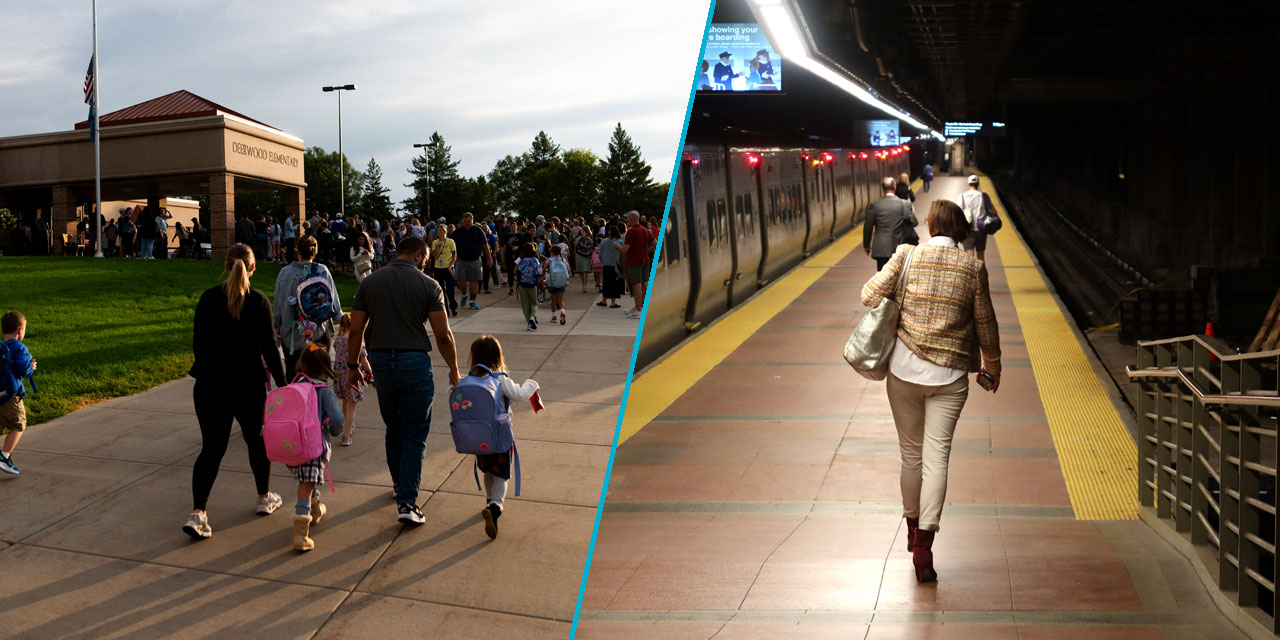
The late Charlie Kirk may have been best known for his conservative politics, but those politics also resonated with traditional values, religious faith, and family life—one side of a critical divide in our society. Life and value choices, even more than ideology, increasingly define how people vote, what they believe, and where they live.
For years, the United States has been evolving into two different countries. One is dominated by often childless, urban renters, many of them college graduates or poor minorities. This America is concentrated in core cities and college towns.
Finally, a reason to check your email.
Sign up for our free newsletter today.
The other America exists in an almost parallel universe—largely suburban, exurban, small town, and rural—but where family, faith, and children constitute the common threads of everyday life. This America was receptive to Kirk’s traditionalist message.
The first America has become a haven for a significant number of postmodernist progressives who largely reject the customary pillars of society such as religion, marriage, and family. Theirs is not a rebellion of peasants and laborers, as occurred from medieval times and on through the early progressive era, but instead an uprising mostly of the urban professional classes. Rather than the mundane concerns of traditional liberals or “sewer socialists,” the postmodernists focus more on environmental catastrophism, gender identity, and radical racial politics. AEI scholar Sam Abrams and I have been following this political trend for years, but new polling shows that it has intensified, particularly among younger single women.
Though economic pressures might eventually make the postmodernists’ cause a broader movement, today’s radical activists seem to respond more to their own inner cultural angst and troubled psychology. Modern progressivism sells best among people who reject traditional notions about families and gender. Today over 28 percent of all Gen Z women, notes Gallup, identify as LGBTQ—more than twice the rate for millennial women and almost three times that for Gen Z men. Over 5 percent of U.S. high school students struggle with gender identity, according to the Centers for Disease Control and Prevention.
Some have learned their gender politics at the feet of their teachers. As one USA Today correspondent wrote in 2017, “the number of women’s and gender studies degrees in the United States has increased by more than 300 percent since 1990, and in 2015, there were more than 2,000 degrees conferred.” Even certain nominally Catholic colleges reject the idea of the sex binary and encourage students to select their own pronouns.
Within this population, political anxiety can lead to violence, or at least acceptance of violence. Nearly 38 percent of respondents and over half of progressives would see the assassination of Donald Trump as “justified,” notes one study. It’s a mindset that predates the Kirk assassination. Many progressives—notably women—celebrated Luigi Mangione’s alleged premeditated murder of UnitedHealth CEO Brian Thompson. In California, a particularly strident center of such views, there’s even a pending proposition on health-care reform named after Mangione.
The postmodernists tend to be highly secular and are likely beneficiaries of America’s long-running “unchurching.” At least until recently, the country has witnessed a steady decline in Christian identification—most notably among mainstream Protestants. Only about 46 percent of Americans born in the 1990s currently identify as Christian. Younger Americans may still embrace of the notion of a spiritual power, but they are leaving religious institutions at a rate four times that of their counterparts three decades ago; almost 40 percent of people aged 18–29 have no religious affiliation.
Today, even conventional liberals, like Virginia senator Tim Kaine, seem ignorant of the nation’s religious foundations. If a religious sensibility shows up on the left these days, it probably expresses itself as neo-druidic nature worship. For many, environmentalism has achieved a quasi-religious appeal, which, if it does not derive its authority from God, acts as the right hand of Gaia and of sanctified science. Indeed, two environmentalists, writing in Time last April, argued that Earth Day should be designated a “religious holiday” just like Easter and Passover.
And yet, the traditionalist view of religion may be showing signs of a resurgence, most pointedly among affluent families. According to some reports, church attendance has quadrupled among Gen Zers in recent years. New research suggests that most teens in this group are interested in learning more about Jesus, with younger cohorts, notably men, leading the way. Some Catholic dioceses, for instance, have reported up to a 70 percent increase in converts this year compared to last; many of these new converts are in their teens and twenties. Pew now notes that Christianity has halted its generational decline, as more people begin to see the appeal, efficacy, and rewards of religious faith and practice. Almost three out of four Americans think religion “mostly helps society,” Pew finds.
Perhaps the most critical divide between the two Americas is over views of marriage, family, and children. In 2024, singles, particularly unmarried women, constituted Kamala Harris’s electoral bulwark, while men and married women tilted more toward Donald Trump. On college campuses, white men are routinely portrayed as toxic, aggressive, and natural-born misogynists. In elite literary circles, male writers have been wished into the cornfield, reflecting narratives about the dangers of masculinity.
In a time when the personal is increasingly political, family values have little value for postmodernist progressives. In universities, queer studies departments subscribe to the goal of replacing the “nuclear family” with a form of collectivized childrearing. One prominent feminist, Sophie Lewis, advocates “full surrogacy” as a replacement for the traditional family. Black Lives Matter included opposition to the nuclear family in its original platform, though family breakdown has hurt young black males most of all.
Support for such views is strongest among unmarried, childless, college-educated women, the base of postmodernist America. Progressive women, notes a recent NBC poll, rank having children 12th among 13 elements describing their “personal definition of success.” In contrast, male Trump voters under age 30 rank having children first among those options. Not surprisingly, the fertility gap between progressives and traditionalists, particularly the religious, has widened since it first surfaced in the 1980s.
The postmodernists are anxious to overthrow the familial ideal. The environmental magazine Grist has envisioned “a hero generation” that will escape the materialist trap of suburban living and work that engulfed their parents. One magazine editor proudly declared herself part of the GINK generation (as in “green inclinations, no kids”) that entails not only a relatively care-free and low-cost adult life but also “a lot of green good that comes from bringing fewer beings onto a polluted and crowded planet.”
Charlie Kirk, a young married man with two kids, epitomized a very different vision—one that appeals to young men, who appear to have become somewhat more socially conservative (and not just in the U.S.). The Right’s recent gains among men extend across ethnicities. Married women have also shifted rightward—and become happier.
The divide between the two Americas on marriage, family, and religion has profound political implications. Democrats fare best in places that have far fewer children. Conservatives dominate rural, exurban, and small-town environments, where people are far more likely to embrace both religion and childrearing. As big-city birth rates plunge, the highest rates are now found in markets with fewer than 250,000 residents, according to an analysis of American Community Survey data by demographer Wendell Cox.
For the next decade or two, at least, progressives will continue to benefit from the rising tide of childlessness. In the U.S., an Institute for Family Studies analysis of 2020 Census data found that one in six women are “child-free” by the time they reach the end of their childbearing years, up from one in ten in 1980. This constituency has less immediate need for such things as good public schools and well-maintained parks, though they may become victims of progressive-enabled social disorder.
The postmodernists may have to consolidate their hold quickly, however. Populations with high religious observance and more conservative politics tend to have higher birthrates; in the more rural parts of the country, big families are becoming a status symbol. The fecundity of the religious, as author Eric Kauffman observes, may allow the religious to “inherit the earth” from secularists rejecting family life.
Which America will prevail? It’s complicated. In the short run, the postmodernists are ascendant within the Democratic Party, particularly in cities where millennials and Gen Z professionals concentrate. Their politics are tied to postmodernist notions about race, equity, and gender.
The cost-of-living crisis remains the biggest opportunity to expand their footprint. Young Americans rank housing, along with inflation, as their top financial worry, driving fears that they may not achieve the foundation of middle-class life. An Institute for Family Studies report found that, since 1970, the share of young adults who own the home they live in has declined from 50 percent to about 25 percent to 30 percent.
When people, especially the young, believe that they cannot earn their way to a better life, they may be tempted to trust their future to the benevolence of the state. This is how the postmodernists might expand their geographic and demographic base. A recent survey suggests that up to half of voters under 40 favor socialism. These sentiments suggest that Zohran Mamdani-like proposals for industrial policy, rent control, and social housing could be attractive, particularly if prices also rise in the periphery.
Ultimately, the future hinges on what Americans, particularly Millennials and Gen Z, decide matters most. Maturity could prove a boon to traditionalists; some 1 million millennials become mothers every year. They may increasingly turn to the familial values of sacrifice and saving for the future, as well as looking for a home with enough space to raise children. Fertility and migration trends suggest that red states will win as many as 11 new congressional seats by 2030, adding to their power in the Electoral College.
The two Americas reflect two opposed visions of a shared national future. If one were to bet, the long-term prospects would seem to favor adherents of Charlie Kirk’s traditionalist vision, but the outcome is far from certain. Meantime, the hardest part may be keeping Kirk’s model of civil debate alive, so that progressives and conservatives can contend with one another in open forums without descending into violence. The two Americas may not agree on much, but they must find a way to coexist.
Photos: Stephen Maturen/Getty Images (left) / Gary Hershorn/Getty Images (right)
Source link


















